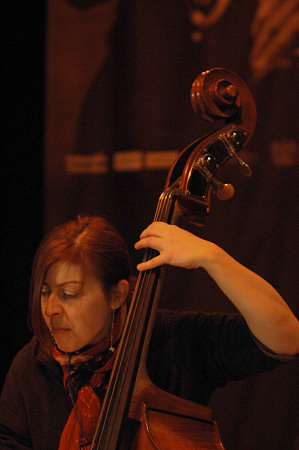Jazz |
||||
Blues Changes |
 |
|||
Blues has a metric form and a fix harmonic; we can play blues in any tonality and the connections between chords and metric are always the same. Most of the blues structures in jazz repertory are in 12 beats; it is still in use a traditional form in 3 chords. (Some examples of this form are “Blue Monk” and “Misterioso” of Theolonius Monk and “Blues by five” of Miles Davis). In FIG.1 we can see changes in F7. The 3 chords are all in dominant seventh: F7, Bb7 and C7. We can call them I-IV and V in their connection with F7. It is also important to know that often in the last beat we use the V degree as a cadenza to start again from the beginning. | ||||
 | ||||
To create a bass line on the blues changes we can use the same approach that we analysed in the previous lesson: the notes of the arpeggio, parts of the scale and chromatism. Now we go to analyse the first 12 beats of a composition of Charles Mingus, a transcription from his Blues “Back home blues” (C. Mingus “Trio” – 1957, with H. Hawes at the piano and D. Richmond at the drums). | ||||
 | ||||
|
This walking bass has rhythmic variations that are typical in the swing. The use of triplets and octaves gives to this walking bass a rhythmic propulsion and the choose of the notes is functional to the harmony. This bass line is very clear and effective. (FIG.2) The notes that Mingus uses to create his line are relative to the scale of every chord, a major scale with the seventh minor, or rather the Misolidia scale, which grows from the V degree in the major modo and which creates the chord of dominant seventh. Instead the notes that don’t belong to the scale are chromatisms, that solve on the arrival note (which is often the fundamental note of the new chord). In the use of chromatism he is using most of all octaves, to underline this moments of resolution. We can find also other notes which are not in the Misolidia scale; in that case he is using the blues scale. The structure of the blues scale is: third minor – tone – semitone – semitone – third minor – tone. (FIG.3) | ||||
 | ||||
Concerning the execution it is important to know that the octaves must be “swing”, so we have not to play them exactly as we see them, but we have to play them as a quaver with point followed by a semiquaver. (FIG.4) (This is not only for bass lines, but also for improvisations). | ||||
 | ||||
To learn the harmonic form of blues by heart is simple, and it is important to know it in every tonality. You can write the walking bass’s lines in the tonality that you prefer. You can use the notes from the arpeggio, parts of the scale, chromatisms and notes from the blues scale. You have to give a sense when you play this composition, during your execution. You can write walking bass’s lines, but you have not to learn them by heart, because walking bass has to be improvised.
Silvia Bolognesi |
||||
Send a comment!!! |
||||




